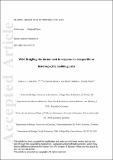Wild fledgling tits do not mob in response to conspecific or heterospecific mobbing calls
Abstract
Mobbing, where birds harass a predator through a combination of vocalizations and stereotyped behaviours, is an effective anti‐predator behaviour for many species. Mobbing may be particularly important for juveniles, as these individuals are often more vulnerable than adults. Although the component behaviours of mobbing are often considered to be un‐learned, there are few confirmatory data, and the developmental trajectory of mobbing is unknown. In this study, we tested whether conspecific or heterospecific mobbing calls initiated mobbing behaviour in juvenile Blue Tits Cyanistes caeruleus. We located wild adult and recently fledged juvenile Blue Tits and presented them with playback recordings of adult conspecific (Blue Tit) and heterospecific (Great Tit Parus major) mobbing alarm calls. Although adult birds readily mob in response to these types of playbacks, juveniles did not exhibit characteristic mobbing behaviour. Some juveniles did, however, exhibit individual components of mobbing behaviour found in mobbing, despite not producing adult‐like mobbing behaviour in response to either conspecific or heterospecific playback. These results suggest that, although birds might be capable of mobbing as juveniles, the associations between the non‐vocal stereotyped mobbing behaviours and mobbing calls may be learned.
Citation
Carlson , N V , Healy , S D & Templeton , C N 2019 , ' Wild fledgling tits do not mob in response to conspecific or heterospecific mobbing calls ' , Ibis , vol. Early View . https://doi.org/10.1111/ibi.12754
Publication
Ibis
Status
Peer reviewed
ISSN
0019-1019Type
Journal article
Description
This research was funded by the Natural Environment Research Council (NE/J018694/1), the Royal Society (RG2012R2), the M. J. Murdock Charitable Trust (2014199) and the University of St Andrews (University of St Andrews 600th Year Scholarship and the St Leonard’s Fee Scholarship).Collections
Items in the St Andrews Research Repository are protected by copyright, with all rights reserved, unless otherwise indicated.

